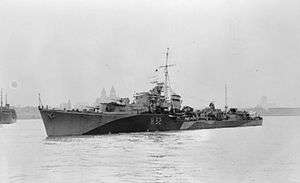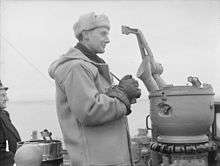HMS Rapid (H32)
 Rapid underway on the River Mersey, February 1943 | |
| History | |
|---|---|
| Name: | HMS Rapid |
| Ordered: | 1 April 1940 |
| Builder: | Cammell Laird & Company |
| Laid down: | 16 June 1941 |
| Launched: | 16 July 1942 |
| Commissioned: | 20 February 1943 |
| Identification: | Pennant number: H32 (F138 from 1953) |
| Fate: | Sunk as target 13 September 1981 |
| General characteristics | |
| Class and type: | R-class destroyer |
HMS Rapid was an R-class destroyer of the Royal Navy that saw service during the Second World War and was sunk as a target in 1981.
Second World War service

During build Rapid was adopted by the civil communities of Sutton and Cheam as part of the Warship Week National savings campaign in 1943.
In February 1943 Rapid began sea trials and was allocated for service with the 11th Destroyer Flotilla.[1] Her first patrols were as convoy defence on Atlantic convoys, travelling to Freetown and by the end of 1943 she was allocated for service in the Eastern Fleet, based in Ceylon.
In March 1945 Rapid was part of Force 68, serving in the Indian Ocean, and later the Pacific. In one operation she was damaged by fire from a shore battery, with 11 killed and 23 wounded. She was towed to Akyab for repairs. The repairs were completed by August 1945 and she returned for service in the planned landings on Malaya, as part of Operation Zipper, which were cancelled on the dropping of the atomic bomb.
Postwar service
In 1946 Rapid commissioned as an air training target ship and attendant destroyer to aircraft carriers. In February 1947 she was based at Rosyth.[2]
.jpg)
Between June 1951 and October 1953 she was converted into a Type 15 fast anti-submarine frigate, by Alex Stephen on the Clyde, with the new pennant number F138.[3] Between 1954 and 1965 Rapid was part of the Reserve Fleet, but did take part in 'Navy Days' in Portsmouth during 1959.[4]
Decommissioning and disposal
In 1965 Rapid was placed on the disposal list. However, in 1966 she was allocated to the shore establishment Caledonia to assist in the sea training of engine room artificers. The ship was used as a day runner from Rosyth Dockyard to give help in certificating artificers, who were under training. Rapid was replaced in this role by the frigate Eastbourne in 1972.
She then became a target ship, being damaged by missiles launches from the guided missile destroyer Bristol in 1976. Following repairs in 1977 she was used as a target ship in Milford Haven. She was placed on the disposal list again in 1978. She was subsequently sunk in the Western Approaches by torpedoes from the submarine Onyx in 1981.
Notes
In addition to training engine room artificers whilst day running Rapid also provided sea training for junior seamen from the shore establishments HMS Raleigh and Ganges.
References
- ↑ Mason, Geoffrey B. (2004). Gordon Smith, ed. "HMS Rapid (H 32) - R-class Destroyer". naval-history.net. Retrieved 11 July 2016.
- ↑ Critchley, Mike, "British Warships Since 1945: Part 3: Destroyers", Maritime Books: Liskeard, UK, 1982. ISBN 0-9506323-9-2, page 52
- ↑ Critchley, Mike, "British Warships Since 1945: Part 3: Destroyers", Maritime Books: Liskeard, UK, 1982. ISBN 0-9506323-9-2, page 52
- ↑ Programme, Navy Days Portsmouth 28-30th March 1959, HMSO
Publications
- Colledge, J. J.; Warlow, Ben (2006) [1969]. Ships of the Royal Navy: The Complete Record of all Fighting Ships of the Royal Navy (Rev. ed.). London: Chatham Publishing. ISBN 978-1-86176-281-8. OCLC 67375475.
- Marriott, Leo, 1983. Royal Navy Frigates 1945-1983, Ian Allen Ltd. ISBN 07110 1322 5
- Raven, Alan; Roberts, John (1978). War Built Destroyers O to Z Classes. London: Bivouac Books. ISBN 0-85680-010-4.
- Whitley, M. J. (1988). Destroyers of World War 2. Annapolis, Maryland: Naval Institute Press. ISBN 0-87021-326-1.